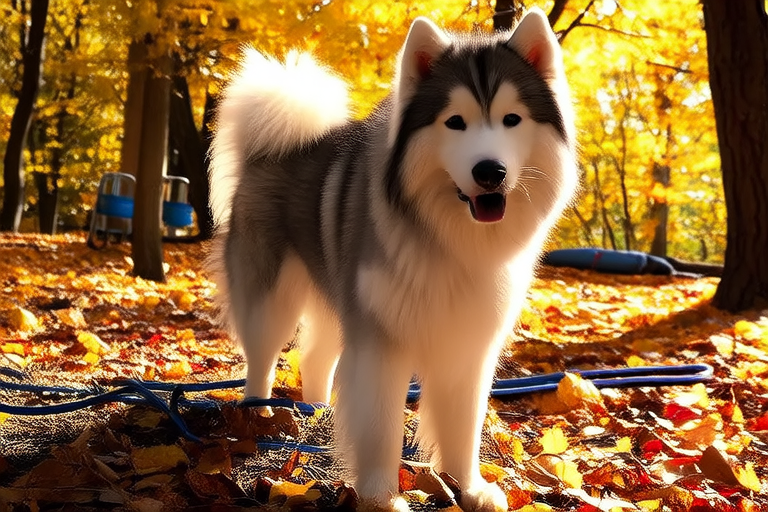Training Tips for First-Time Owners of Lovable Yet Mischievous Siberian Huskies
Welcome to the world of Siberian Huskies! These lovable yet mischievous dogs have captured the hearts of many with their striking blue or multi-colored eyes and thick coats. However, their independent nature can make them challenging to train. This comprehensive guide will provide you with essential advice on understanding their character, effective training methods, exercise requirements, socialization techniques, and managing common behavioral issues. Emphasis will be placed on consistency, patience, and positive reinforcement to help you bond successfully with your Siberian Husky.
Understanding Their Independent Nature
Siberian Huskies are descendants of sled dogs and have been bred for thousands of years to pull sleds across long distances. They are intelligent, energetic, and independent, which can sometimes lead to stubbornness. It is crucial to understand that these traits are part of their genetic makeup and not a reflection of poor breeding. Instead, they are indicators of a dog that thrives on mental and physical stimulation.
Dr. Stanley Coren, a renowned canine behaviorist, emphasizes the importance of recognizing and respecting your Siberian Husky’s independence. He suggests that owners should approach training with a mindset that acknowledges the dog’s intelligence and need for autonomy. This understanding fosters a respectful and trusting relationship between owner and dog.
Effective Training Methods
Consistency, patience, and positive reinforcement are key elements in training your Siberian Husky. Positive reinforcement involves rewarding your dog for good behavior, which encourages repetition of the desired actions. For example, if your Husky sits on command, reward it with a treat and praise. Over time, your dog will associate the command with the reward, leading to more consistent obedience.
Real-life example: Sarah, a first-time owner, struggled with housebreaking her Siberian Husky, Max. She decided to implement a strict routine, taking Max out every two hours and praising him each time he relieved himself outside. Within a few weeks, Max had learned the correct behavior, and Sarah was rewarded with a well-trained companion.
Expert insight: Dr. Karen Overall, a board-certified veterinary behaviorist, recommends using clicker training as an effective method for reinforcing desired behaviors. Clicker training uses a small handheld device that makes a clicking sound when pressed. The click serves as a marker, signaling the exact moment your dog performs the correct action. Pairing the click with a treat reinforces the behavior even further.
Exercise Requirements
Siberian Huskies are high-energy dogs that require regular exercise to maintain both physical and mental health. A lack of sufficient exercise can lead to destructive behavior, such as chewing furniture or digging holes in the yard. On average, a Siberian Husky needs at least one hour of vigorous exercise daily, including walks, runs, and playtime.
Real-life example: John, who adopted a Siberian Husky named Bella, noticed that she became increasingly restless and destructive when left alone for extended periods. After incorporating daily jogs and agility training into her routine, Bella became calmer and more focused, reducing her destructive tendencies.
Expert insight: Dr. James Serpell, director of the Center for the Interaction of Animals and Society at the University of Pennsylvania, advises owners to engage in activities that stimulate both the body and mind of their Siberian Huskies. Incorporating puzzle toys, interactive games, and obedience training can help keep your dog mentally engaged while providing physical exercise.
Socialization Techniques
Socializing your Siberian Husky from an early age is essential for developing well-rounded and friendly behavior. Expose your puppy to various environments, people, and other animals to help them become comfortable and confident in different situations. Socialization should continue throughout your dog’s life, ensuring they remain adaptable and sociable.
Real-life example: Emily, a first-time owner, took her Siberian Husky, Charlie, to local dog parks and organized playdates with friends’ dogs. By gradually introducing Charlie to new experiences and people, she helped him develop into a friendly and outgoing adult dog.
Expert insight: Dr. Patricia McConnell, a certified applied animal behaviorist, recommends starting socialization early, ideally between the ages of three and sixteen weeks. During this critical period, puppies are most receptive to learning about their environment and how to interact with others. Regular exposure to various stimuli helps prevent fear-based aggression and promotes positive social interactions.
Managing Common Behavioral Issues
Despite their intelligence and trainability, Siberian Huskies may exhibit some common behavioral issues. These include excessive barking, chewing, and digging. Addressing these issues requires patience, consistency, and appropriate training techniques.
Excessive barking can be managed by identifying the cause and addressing it directly. If your dog barks due to boredom, increase its exercise and mental stimulation. If the barking is a result of separation anxiety, consider crate training and gradual desensitization exercises.
Chewing and digging are natural behaviors for Siberian Huskies but can become problematic if not redirected. Provide appropriate chew toys and supervise your dog during playtime to teach it what is acceptable to chew. For digging, create a designated area for your dog to dig and redirect it there whenever it starts digging elsewhere.
Real-life example: Lisa, a first-time owner, struggled with her Siberian Husky, Daisy, chewing on furniture and digging up her garden. After consulting with a professional trainer, Lisa implemented a strict routine, providing Daisy with plenty of mental and physical stimulation and redirecting her chewing and digging behaviors. With consistent effort, Daisy’s destructive tendencies were significantly reduced.
Expert insight: Dr. Nicholas Dodman, a veterinary behaviorist, advises owners to address behavioral issues promptly and consistently. Ignoring or punishing inappropriate behavior can exacerbate the problem, while positive reinforcement and redirection can help your dog learn acceptable alternatives.
Conclusion
Training your Siberian Husky requires dedication, patience, and consistency. By understanding their independent nature, employing effective training methods, ensuring adequate exercise, and practicing proper socialization techniques, you can successfully bond with and train your lovable yet mischievous Siberian Husky. Remember to stay patient and positive throughout the process, and seek professional guidance if needed. With time and effort, you and your Siberian Husky will form a strong, loving bond that will last a lifetime.
